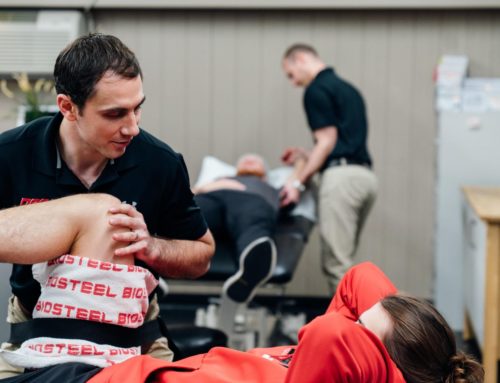If your sport or activity requires you to bend in ways most people find ‘unnatural’, likely you are used to spending extended periods of time in splits, bridges, etc. In many sports such as gymnastics, dance, cheerleading, and figure skating your typical warm up likely includes holding your various stretches for minutes at a time. While this is traditionally thought to increase flexibility and assumed a great way to prepare for your sport, this is not exactly true. Static stretching (holding one position) may play a role in decreasing pain in these extreme positions, but they don’t appear to make any physical changes to the muscles’ elasticity. Even more important, this static stretching can actually hinder your performance! Studies show that prolonged stretch on a muscle, when done independently, can inhibit its ability to produce power.
So how do you better prepare your muscles for your big performance where you need to use that flexibility?
Eccentric Loading
Okay so I don’t have to convince you that you not only need to be flexible, you need to be strong! But here is the tricky part: You have to be strong from a position of relative weakness – where your muscle fibers are in their most elongated position. Think of a simple round-off for example. When you push off your front leg you’re putting your hamstring (the bulk of muscle on the back of your thigh) on stretch at both its end and then asking it to propel you upside down.
Eccentric loading means strengthening the muscle as it is lengthening or in a lengthened position. This is a fantastic way to build strength as it is putting more stress on the muscle than when you are simply bringing each end of the muscle closer together (concentric loading). And here’s a bonus: according to research, this is actually a great way to structurally elongate that muscle – meaning more flexible!
Try: Eccentric hamstring sliders, eccentric pull ups/chin ups, rear foot elevated split squats
Dynamic Stretching
If you think about it, most of the time you’re passing through these extreme and beautiful ranges of movement fairly quickly, because let’s face it – watching someone sit in one position is not the most entertaining. This means that for the most part, your routine will require your muscles to move into your most flexible position, and bring you back to get ready for your next move in a matter of moments. You should absolutely be preparing your body this way! Dynamic stretching means stretching with movement created by the muscles themselves and it is a great way to prepare your body for your performance with a dual function: warm up and stretch.
Try: Needle kicks, walking front kicks, active arm raise on stomach
Warm Up
If you feel that pre-competition split is a must – I get it. Doing your classic static stretching is not a bad thing, but make sure you’re preparing your body for it. Be sure to give your muscles a good warm up giving each body part some extra blood flow and bringing your heart rate up a bit. Another thing to consider is not keeping splits as your last element of general warm up before you begin warming up your skills or routine. Be sure to set your muscles up to be able to produce the power you need for those jumps, tumbling, and turns, while also preparing them to be in those extreme positions during your performance.
Try: Light jog, jumping jacks, bear walks, handstand walking
At the end of the day, your pre-competition routine should include multiple elements of movement and stretching in different ways to prepare yourself for what you’re about to do. The important thing to remember is not to use only one type of stretching (static) to then ask your body to do very dynamic and powerful skills.
If you have questions about any of the information above, or are looking to better manage those pesky competition strains, please contact [email protected]
Written by: Sam Poulin, Resident Physiotherapist
References:
Weppler CH, Magnusson SP. Increasing muscle extensibility: a matter of increasing length or modifying sensation? Phys Ther. 2010 Mar;90(3):438-49. doi: 10.2522/ptj.20090012. Epub 2010 Jan 14. PMID: 20075147.
O’Sullivan K, McAuliffe S, Deburca N. The effects of eccentric training on lower limb flexibility: a systematic review. Br J Sports Med. 2012 Sep;46(12):838-45. doi: 10.1136/bjsports-2011-090835. Epub 2012 Apr 20. PMID: 22522590.
Chaabene, H., Behm, D. G., Negra, Y., & Granacher, U. (2019). Acute Effects of Static Stretching on Muscle Strength and Power: An Attempt to Clarify Previous Caveats. Frontiers in Physiology, 10, 1468. https://doi.org/10.3389/fphys.2019.01468






